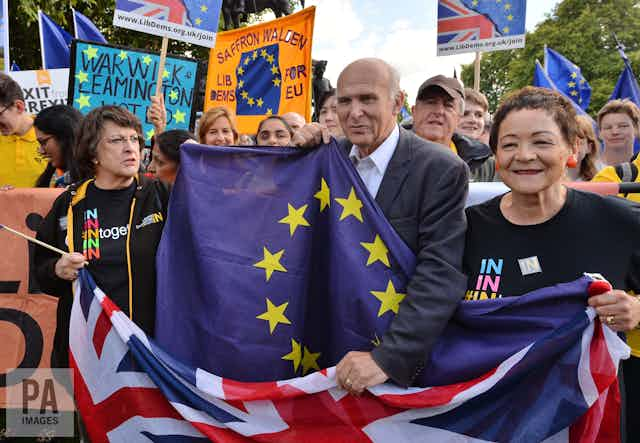The Liberal Democrats are in Bournemouth for their annual party conference and it seems a lifetime ago that they were part of a coalition government running the UK, with their then leader Nick Clegg ensconced as deputy prime minister.
Under the recently installed leadership of Vince Cable, freshly returned as an MP in 2017 and viewed as an experienced elder statesman of British politics, the party is currently doing its utmost to pick itself up from some major recent political setbacks. Cable will be hoping that the Liberal Democrats can again become a genuine political force. The goal will be to successfully run some high-profile local authorities, win parliamentary by-elections and even to once again wield national power.
Such a revival is easier said than done. The party’s rise and fall has been one of the most tumultuous episodes of recent political times. The high came after the inconclusive outcome of the 2010 general election, when Clegg’s party emerged holding the balance of power, ostensibly in the “national interest”. He negotiated to become the minority partner in the UK’s first peacetime coalition since the 1930s.
This scenario gave the so-called third party of UK politics an opportunity that many of its members thought would never arrive – holding a degree of genuine national political power. The Conservative-Liberal Democrat coalition subsequently surprised many critics to survive a full five-year term.
Yet this renaissance could not sustain itself while the Liberal Democrats held high office. The decision to become junior coalition partners can, in retrospect, be seen as the ill-fated catalyst for the party’s rapid decline. From 2010 onwards there was consequently a dramatic collapse in support for Clegg and his party. The nadir came in 2015, when they went into a general election with 57 seats and came out with just eight.
They had ultimately become the “fall-guys” for various unpopular policies of the 2010-15 coalition government. The perceived identity of the Liberal Democrats as a radical party of reform was also largely obliterated by its association with Conservative austerity. This was despite much-publicised previous opposition to this economic policy approach.
A second referendum
After being ruthlessly attacked and targeted by its Conservative “allies” at the 2015 general election, the Liberal Democrats have had to re-adjust to life in the political wilderness.
After the 2015 election, Clegg’s successor as leader Tim Farron sought to energetically improve the party’s fortunes, and marginal glimmers of progress could be seen in some local authority elections. A major opportunity to regenerate the party’s image came with the 2016 Brexit referendum. As a fiercely pro-European party, the Liberal Democrats offered an unashamedly positive case for remaining within the EU.
But the Leave vote put the Liberal Democrats on the wrong side of the landmark outcome. The party looked out of step with public opinion and its subsequent determined call for a second referendum has earned it scorn from those across the political spectrum.

This ardent pro-European position was nevertheless viewed by some as offering the party an opportunity at the unexpected general election of 2017. Party strategists calculated that the political support of a large chunk of the 48% Remainers was up for grabs. As things transpired, such optimism proved false. In 2017 the Liberal Democrat share of the vote actually fell to 7.4% and it remained as fourth party in Parliament, behind the SNP. It did increase its MPs to 12 (despite Nick Clegg losing his own seat) but this remained way behind the party’s post-war zenith of parliamentary representation of 62 MPs in 2005.
Now what?
So what now for the Liberal Democrats? The party’s fall has been brutal, and its image appears to have been seriously tarnished by its somewhat toxic association with the Conservatives between 2010-15. This is despite defensive claims that its influence moderated many harsher Conservative proposals within the coalition.
Cable needs to offer a distinct message that appeals to a volatile electorate. Voters are increasingly devoid of long-term loyalty, as the Liberal Democrats have found to their cost.
As a “centre party” it has particularly found itself squeezed by heightened tactical voting amid polarised and ideological two-party politics, with the Conservative-Labour share of the vote in 2017 reaching its highest level at a general election since 1970.
The party’s best strategic option may be to play the long game. It should consolidate its principled pro-EU position under Cable’s apparent “safe pair of hands”. On this premise, if Brexit becomes the disaster that Liberal Democrat figures have consistently predicted, then the British public may be willing to eventually forgive, and once again turn to the party in the “national interest”.

